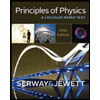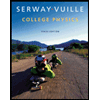
Fundamentals of Physics Extended
10th Edition
ISBN: 9781118230725
Author: David Halliday, Robert Resnick, Jearl Walker
Publisher: Wiley, John & Sons, Incorporated
expand_more
expand_more
format_list_bulleted
Concept explainers
Textbook Question
Chapter 14, Problem 3Q
A boat with an anchor on board floats in a swimming pool that is somewhat wider than the boat. Does the pool water level move up, move down, or remain the same if the anchor is (a) dropped into the water or (b) thrown onto the surrounding ground? (c) Does the water level in the pool move upward, move downward, or remain the same if, instead, a cork is dropped from the boat into the water, where it floats?
Expert Solution & Answer
Want to see the full answer?
Check out a sample textbook solution
Chapter 14 Solutions
Fundamentals of Physics Extended
Ch. 14 - We fully submerge an irregular 3 kg lump of...Ch. 14 - Figure 14-21 shows four situations in which a red...Ch. 14 - A boat with an anchor on board floats in a...Ch. 14 - Figure 14-22 shows a tank filled with water. Five...Ch. 14 - The teapot effect. Water poured slowly from a...Ch. 14 - Figure 14-24 shows three identical open-top...Ch. 14 - Figure 14-25 shows four arrangements of pipes...Ch. 14 - A rectangular block is pushed face-down into three...Ch. 14 - Water flows smoothly in a horizontal pipe. Figure...Ch. 14 - We have three containers with different Liquids....
Ch. 14 - ILW A fish maintains its depth in fresh water by...Ch. 14 - A partially evacuated airtight container has a...Ch. 14 - SSM Find the pressure increase in the fluid in a...Ch. 14 - Three liquids that will not mix are poured into a...Ch. 14 - SSM An office window has dimensions 3.4 m by 2.1...Ch. 14 - Prob. 6PCh. 14 - In 1654 Otto von Guericke, inventor of the air...Ch. 14 - The bends during flight. Anyone who scuba dives is...Ch. 14 - Blood pressure in Argentinosaurus. a If this...Ch. 14 - The plastic tube in Fig. 14-30 has a...Ch. 14 - Giraffe bending to drink. In a giraffe with its...Ch. 14 - The maximum depth dmax that a diver can snorkel is...Ch. 14 - At a depth of 10.5 km, the Challenger Deep in the...Ch. 14 - Calculate the hydrostatic difference in blood...Ch. 14 - What gauge pressure must a machine produce in...Ch. 14 - Snorkeling by humans and elephants. When a person...Ch. 14 - SSM Crew members attempt to escape from a damaged...Ch. 14 - In Fig. 14-32, an open tube of length L = 1.8 m...Ch. 14 - GO A large aquarium of height 5.00 m is filled...Ch. 14 - The L-shaped fish tank shown in Fig. 14-33 is...Ch. 14 - SSM Two identical cylindrical vessels with their...Ch. 14 - Prob. 22PCh. 14 - GO In analyzing certain geological features, it is...Ch. 14 - GO In Fig. 14-35, water stands at depth D = 35.0 m...Ch. 14 - In one observation, the column in a mercury...Ch. 14 - To suck lemonade of density 1000 kg/m3 up a straw...Ch. 14 - SSM What would be the height of the atmosphere if...Ch. 14 - A piston of cross-sectional area a is used in a...Ch. 14 - In Fig 14-37, a spring of spring constant 3.00 ...Ch. 14 - A 5.00 kg object is released from rest while fully...Ch. 14 - SSM A block of wood floats in fresh water with...Ch. 14 - In Fig. 14-38, a cube of edge length L = 0.600 m...Ch. 14 - SSM An iron anchor of density 7870kg/m3 appears...Ch. 14 - A boat floating in fresh water displaces water...Ch. 14 - Three children, each of weight 356 N, make a log...Ch. 14 - GO In Fig. 14-39a, a rectangular block is...Ch. 14 - ILW A hollow spherical iron shell floats almost...Ch. 14 - GO A small solid ball is released from rest while...Ch. 14 - SSM WWW A hollow sphere of inner radius 8.0 cm and...Ch. 14 - Lurking alligators. An alligator waits for prey by...Ch. 14 - What fraction of the volume of an iceberg density...Ch. 14 - A Flotation device is in the shape of a right...Ch. 14 - When researchers find a reasonably complete fossil...Ch. 14 - A wood block mass 3.67 kg, density 600 kg/m3 is...Ch. 14 - GO An iron casting containing a number of cavities...Ch. 14 - GO Suppose that you release a small ball from rest...Ch. 14 - The volume of air space in the passenger...Ch. 14 - GO Figure 14-44 shows an iron ball suspended by...Ch. 14 - Canal effect. Figure 14-45 shows an anchored barge...Ch. 14 - Figure 14-46 shows two sections of an old pipe...Ch. 14 - SSM A garden hose with an internal diameter of 1.9...Ch. 14 - Two streams merge to form a river. One stream has...Ch. 14 - SSM Water is pumped steadily out of a flooded...Ch. 14 - GO The water flowing through a 1.9 cm inside...Ch. 14 - How much work is done by pressure in forcing 1.4...Ch. 14 - Suppose that two tanks, 1 and 2, each with a large...Ch. 14 - SSM A cylindrical tank with a large diameter is...Ch. 14 - The intake in Fig. 14-47 has cross-sectional area...Ch. 14 - SSM Water is moving with a speed of 5.0 m/s...Ch. 14 - Models of torpedoes are sometimes tested in a...Ch. 14 - ILW A water pipe having a 2.5 cm inside diameter...Ch. 14 - A pitot tube Fig. 14-48 is used to determine the...Ch. 14 - Prob. 63PCh. 14 - GO In Fig. 14-49, water flows through a horizontal...Ch. 14 - SSM WWW A venturi meter is used to measure the...Ch. 14 - Consider the venturi tube of Problem 65 and Fig....Ch. 14 - ILW In Fig. 14-51, the fresh water behind a...Ch. 14 - GO Fresh water flows horizontally from pipe...Ch. 14 - A liquid of density 900 kg/m3 flows through a...Ch. 14 - GO In Fig. 14-53, water flows steadily from the...Ch. 14 - Figure 14-54 shows a stream of water flowing...Ch. 14 - GO A very simplified schematic of the rain...Ch. 14 - About one-third of the body of a person floating...Ch. 14 - A simple open U-tube contains mercury. When 11.2...Ch. 14 - If a bubble in sparkling water accelerates upward...Ch. 14 - Suppose that your body has a uniform density of...Ch. 14 - Prob. 77PCh. 14 - Caught in an avalanche, a skier is fully submerged...Ch. 14 - An object hangs from a spring balance. The balance...Ch. 14 - In an experiment, a rectangular block with height...Ch. 14 - SSM Figure 14-30 shows a modified U-tube: the...Ch. 14 - What is the acceleration of a rising hot-air...Ch. 14 - Figure 14-56 shows a siphon, which is a device for...Ch. 14 - When you cough, you expel air at high speed...Ch. 14 - A tin can has a total volume of 1200 cm3 and a...Ch. 14 - The tension in a string holding a solid block...Ch. 14 - What is the minimum area in square meters of the...Ch. 14 - A 8.60 kg sphere of radius 6.22 cm is at a depth...Ch. 14 - a For seawater of density 1.03 g/cm3, find the...Ch. 14 - The sewage outlet of a house constructed on a...
Additional Science Textbook Solutions
Find more solutions based on key concepts
The given sentence.
Glencoe Physical Science 2012 Student Edition (Glencoe Science) (McGraw-Hill Education)
Choose the best answer to each of the following. Explain your reasoning. The age of our solar system is about (...
The Cosmic Perspective Fundamentals (2nd Edition)
56. Global Positioning System. Learn more about the global positioning system and its uses. Write a short repo...
The Cosmic Perspective
1. What are the units of measurement for tangential speed? For rotational speed?
Conceptual Physics (12th Edition)
62. Next, a particle with the same mass and velocity as the particle in Figure P24.59 enters the velocity selec...
College Physics: A Strategic Approach (4th Edition)
Knowledge Booster
Learn more about
Need a deep-dive on the concept behind this application? Look no further. Learn more about this topic, physics and related others by exploring similar questions and additional content below.Similar questions
- A childs toy floats in a swimming pool. The buoyant force exerted on the toy depends on the volume of ___. (3.6) (a) water in the pool (b) the pool (c) the water displaced (d) the toy under waterarrow_forwardA backyard swimming pool with a circular base of diameter 6.00 m is filled to depth 1.50 m. (a) Find the absolute pressure at the bottom of the pool. (b) Two persons with combined mass 150 kg enter the pool and float quietly there. No water overflows. Find the pressure increase at the bottom of the pool after they enter the pool and float.arrow_forwardA 1.00-kg beaker containing 2.00 kg of oil (density = 916 kg/m3) rests on a scale. A 2.00-kg block of iron is suspended from a spring scale and is completely submerged in the oil (Fig. P9.31). Find the equilibrium readings of both scales. Figure P9.31arrow_forward
- Two thin-walled drinking glasses having equal base areas but different shapes, with very different cross-sectional areas above the base, are filled to the same level with water. According to the expression P = P0 + gh, the pressure is the same at the bottom of both glasses. In view of this equality, why does one weigh more than the other?arrow_forwardA 1.00-kg beaker containing 2.00 kg of oil (density = 916.0 kg/m3) rests on a scale. A 2.00-kg block of iron suspended from a spring scale is completely submerged in the oil as shown in Figure P15.63. Determine the equilibrium readings of both scales. Figure P15.63 Problems 63 and 64.arrow_forwardWater flows through a pipe that gradually descends from a height of 6.78 m to the ground. Near the top, the cross-sectional area is 0.400 m2, and the pipe gradually widens so that its area near the ground is 0.800 m2. Water leaves the pipe at a speed of 16.8 m/s. What is the difference in the water pressure between the top and bottom of the pipe?arrow_forward
- Why is it difficult to swim under water in the Great Salt Lake?arrow_forwardA beaker of mass mb containing oil of mass mo and density o rests on a scale. A block of iron of mass mFe suspended from a spring scale is completely submerged in the oil as shown in Figure P15.63. Determine the equilibrium readings of both scales. Figure P15.63 Problems 63 and 64.arrow_forwardA horizontal pipe 10.0 cm in diameter has a smooth reduction to a pipe 5.00 cm in diameter. If the pressure of the water in the larger pipe is 8.00 104 Pa and the pressure in the smaller pipe is 6.00 104 Pa, at what rate does water flow through the pipes?arrow_forward
- A small piece of steel is tied to a block of wood. When the wood is placed in a tub of water with the steel on top, half of the block is submerged. Now the block is inverted so that the steel is under water. (i) Does the amount of the block submerged (a) increase, (b) decrease, or (c) remain the same? (ii) What happens to the water level in the tub when the block is inverted? (a) It rises. (b) It falls. (c) It remains the same.arrow_forwardA hot-air balloon consists of a basket banging beneath a large envelope filled with hot air. A topical hot-air balloon has a total mass of 545 kg. including passengers in its basket, and holds 2.55 103 m3 of hot air in its envelope. If the ambient air density is 1.25 kg/m3, determine the density of hot air inside the envelope when the balloon is neutrally buoyant. Neglect the volume of air displaced by the basket and | passengers.arrow_forwardA backyard swimming pool with a circular base of diameter 6.00 m is filled to depth 1.50 m. (a) Find the absolute pressure at the bottom of the pool. (b) Two persons with combined mass 150 kg enter the pool and float quietly there. No water overflown. Find the pressure increase at the bottom of the pool after they enter the pool and float.arrow_forward
arrow_back_ios
SEE MORE QUESTIONS
arrow_forward_ios
Recommended textbooks for you
 An Introduction to Physical SciencePhysicsISBN:9781305079137Author:James Shipman, Jerry D. Wilson, Charles A. Higgins, Omar TorresPublisher:Cengage Learning
An Introduction to Physical SciencePhysicsISBN:9781305079137Author:James Shipman, Jerry D. Wilson, Charles A. Higgins, Omar TorresPublisher:Cengage Learning Physics for Scientists and Engineers, Technology ...PhysicsISBN:9781305116399Author:Raymond A. Serway, John W. JewettPublisher:Cengage Learning
Physics for Scientists and Engineers, Technology ...PhysicsISBN:9781305116399Author:Raymond A. Serway, John W. JewettPublisher:Cengage Learning Principles of Physics: A Calculus-Based TextPhysicsISBN:9781133104261Author:Raymond A. Serway, John W. JewettPublisher:Cengage Learning
Principles of Physics: A Calculus-Based TextPhysicsISBN:9781133104261Author:Raymond A. Serway, John W. JewettPublisher:Cengage Learning Physics for Scientists and Engineers: Foundations...PhysicsISBN:9781133939146Author:Katz, Debora M.Publisher:Cengage Learning
Physics for Scientists and Engineers: Foundations...PhysicsISBN:9781133939146Author:Katz, Debora M.Publisher:Cengage Learning College PhysicsPhysicsISBN:9781305952300Author:Raymond A. Serway, Chris VuillePublisher:Cengage Learning
College PhysicsPhysicsISBN:9781305952300Author:Raymond A. Serway, Chris VuillePublisher:Cengage Learning College PhysicsPhysicsISBN:9781285737027Author:Raymond A. Serway, Chris VuillePublisher:Cengage Learning
College PhysicsPhysicsISBN:9781285737027Author:Raymond A. Serway, Chris VuillePublisher:Cengage Learning

An Introduction to Physical Science
Physics
ISBN:9781305079137
Author:James Shipman, Jerry D. Wilson, Charles A. Higgins, Omar Torres
Publisher:Cengage Learning

Physics for Scientists and Engineers, Technology ...
Physics
ISBN:9781305116399
Author:Raymond A. Serway, John W. Jewett
Publisher:Cengage Learning

Principles of Physics: A Calculus-Based Text
Physics
ISBN:9781133104261
Author:Raymond A. Serway, John W. Jewett
Publisher:Cengage Learning

Physics for Scientists and Engineers: Foundations...
Physics
ISBN:9781133939146
Author:Katz, Debora M.
Publisher:Cengage Learning

College Physics
Physics
ISBN:9781305952300
Author:Raymond A. Serway, Chris Vuille
Publisher:Cengage Learning

College Physics
Physics
ISBN:9781285737027
Author:Raymond A. Serway, Chris Vuille
Publisher:Cengage Learning
Fluids in Motion: Crash Course Physics #15; Author: Crash Course;https://www.youtube.com/watch?v=fJefjG3xhW0;License: Standard YouTube License, CC-BY